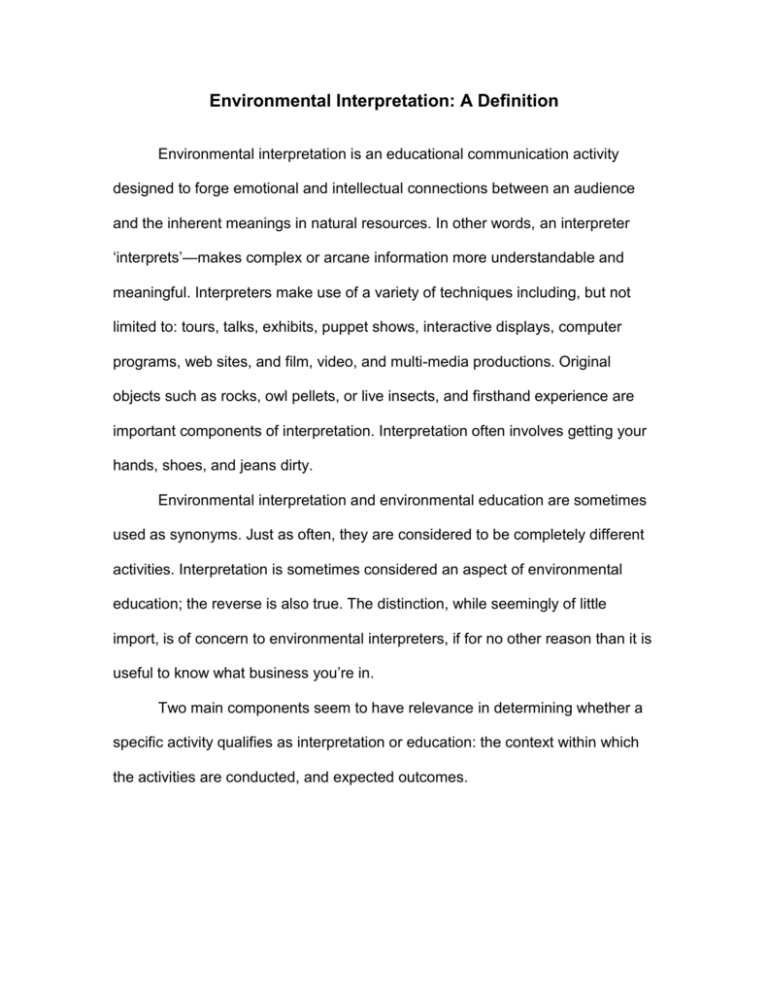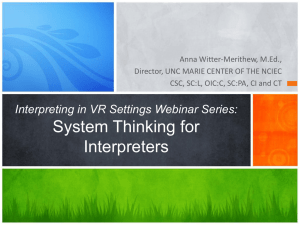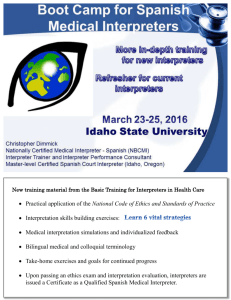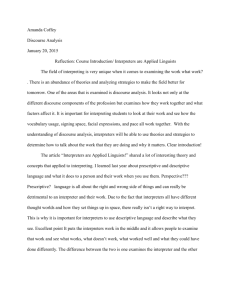Environmental Interpretation
advertisement

Environmental Interpretation: A Definition Environmental interpretation is an educational communication activity designed to forge emotional and intellectual connections between an audience and the inherent meanings in natural resources. In other words, an interpreter ‘interprets’—makes complex or arcane information more understandable and meaningful. Interpreters make use of a variety of techniques including, but not limited to: tours, talks, exhibits, puppet shows, interactive displays, computer programs, web sites, and film, video, and multi-media productions. Original objects such as rocks, owl pellets, or live insects, and firsthand experience are important components of interpretation. Interpretation often involves getting your hands, shoes, and jeans dirty. Environmental interpretation and environmental education are sometimes used as synonyms. Just as often, they are considered to be completely different activities. Interpretation is sometimes considered an aspect of environmental education; the reverse is also true. The distinction, while seemingly of little import, is of concern to environmental interpreters, if for no other reason than it is useful to know what business you’re in. Two main components seem to have relevance in determining whether a specific activity qualifies as interpretation or education: the context within which the activities are conducted, and expected outcomes. Context Environmental interpretation typically occurs in informal, leisure-time settings with voluntary audiences—visitors to parks, nature centers, and wildlife refuges and preserves—who have the freedom to come and go as they choose and to select their level of involvement. Interpretive activities are most often oneshot experiences whose primary purpose is recreational. Education tends to be associated with formal institutions, captive audiences, and sequential learning occurring over an extended period of time. Environmental education is part of a pedagogical system, with educational goals, objectives, and curriculum designed hierarchically to build upon and reinforce concepts. However, the fields of interpretation and environmental education often overlap. Good interpretation, like good education, is relevant, organized, and thematic. Good interpreters teach; good teachers interpret. Further—and more obvious—overlap occurs when teachers plan field trips to increase student interest and extend student experience or when interpreters take their programs into the schools (an increasingly common occurrence as school districts lose funding for buses). Expected outcomes Interpretation plants the environmental education seed. Awareness of environmental issues and appreciation (emotional and intellectual connections) are the primary expected outcomes of interpretation. Therefore, interpretation must be personal. If the interpreter cannot somehow relate the object being interpreted to something within the personality or experience of the visitor, the experience will be sterile—no connections will be made; no new awareness will dawn; the seed will not be nurtured and cannot grow. Learning is a valuable and expected outcome of interpretive activities, but recreational enhancement is often of more concern to participants. The aims of environmental education are wider: increased specialized knowledge, attitude change, behavior change, stewardship development, and environmental action. Time is a necessary element in the development of the sensitivity, knowledge, and attitudes needed for a positive environmental ethic, and time is a major advantage that environmental educators have over interpreters. Conclusion The question, “How are environmental interpretation and environmental education different?” may be a no-brainer, best answered with another question: “Who cares?” If the world agreed tomorrow on the respective definitions, neither ‘interpreters’ nor ‘educators’ would be likely to report for work and do what they do differently. And yet, when people cannot agree among themselves as to their roles, misunderstandings become widespread and budgetary justifications becomes difficult. So perhaps, while it doesn’t matter much to the audience whether the naturalist thinks she is an interpreter or an educator, a clearer definition is needed, after all. Intended Audience: 1. Environmental interpreters, particularly those new to the profession 2. Educators, particularly those interested in incorporating environmental education into their curriculum.











